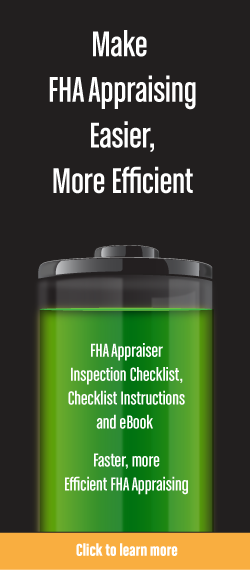
|
Published by OREP, E&O Insurance Experts | Jan. 18, 2012 | Vol. 242 |

|
> Surveys
> Blogs
> Leave Comments Below |
An
appraiser in Arizona was completing 1,000 appraisals a year (2005-2007).
He had no staff or other appraisers, just him and his computer working out
of his den.
1,000 Appraisals a Year: Realities of Appraiser Liability
By Richard Hagar, SRA
At American Home Appraisals, we provide extensive expert witness work for a variety of law firms all across the U.S.
When attorneys call and engage our services, we don’t always know if the appraiser is the plaintiff or the defendant. As a result, we sometimes are on the side of the appraiser and sometimes not. We try not to pick sides, we’re simply the experts hired to explain how an appraiser’s report, methodologies or standard of care fits within USPAP and Fannie Mae requirements or the Interagency Appraisal Guidelines. We are the people who try to help both sides understand the appraisal process.
In a series of articles and Webinars for OREP/Working RE, we’ll explain some of the appraisal, AMC and lending failures that I’ve seen over the past year as well as your Rights and Responsibilities in Understanding the New Mandatory Reporting Laws. Hopefully appraisers will learn how to avoid making the same mistakes as many others. Information comes from civil and criminal cases where we were hired as the expert-witness or consultant. So, with that said, please don’t shoot the messenger - I’m just trying to help!
Case #1:
One Thousand Appraisals a Year
An
appraiser in Arizona was completing 1,000 appraisals a year (2005-2007). He had
no staff or other appraisers, just him and his computer working out of his den.
A thousand appraisals works out to roughly three per day, every day, including
Sundays, Christmas and New Years. (Now that’s dedication.)
In deposition he was asked how he produced so many appraisals. His response was: “I really like appraising.”
Problem
The quality control (QC) department
of several banks discovered failures in his work during the initial underwriting
phase and a year later during their “after closing” review. You should
understand that the loans were not going bad (yet) but the appraisals were being
“reviewed” for quality control and he was failing.
The appraiser was placed on the lenders internal black list and the appraiser was turned into the state for disciplinary action. In 2007, the loans started to go into default and the bank losses mounted. Full reviews indicated that the appraisals had problems and incorrect values. A year after closing the loan, the bank was experiencing losses so they sued the mortgage broker for selecting the appraiser and the appraiser for producing substandard appraisals.
In other words, the bank wanted the mortgage
broker and appraiser to pay for their loan losses. The suit against the
appraiser was for more than $2.5 million (ouch) based upon the failure of 10
reports.
At this point, most states place their official investigations on hold. They
wait until the civil actions are concluded before they finalize theirs.
What we found
We were hired by the law firm
representing the BIG bank. We explained to the law firm that the appraiser’s
value conclusion was not the end-all and be-all. The bigger question is, did
the appraiser utilize the correct process in coming to the value? After all,
even bad appraisers using a bad process can come to the correct value
conclusion. For bad appraisers it’s more of a blind dart throw; for good
appraisers it’s accuracy.
The law firm issued the appraiser a subpoena demanding 10 work files. The files were handed over to us and we were asked to see if the work files, methodologies and final report conformed to all appraisal laws, regulations and guidelines. We got to look at the appraiser’s entire work file including every note, diagram, MLS data sheet and Email. That alone would send shivers up the spines of most appraisers.
In reviewing his work we found the following
general failures:
1.
Bad initial appraisal orders;
2.
Incomplete work files;
3.
Poor property descriptions;
4.
Poor “comparable” selection;
5.
Failure to accurately describe the subject;
6.
Failure to accurately describe the comparables;
7.
Failure to inspect the comparables;
8.
No support for adjustments;
9.
No support for land value or construction costs;
10. Utilized
MLS photographs instead of personally inspecting the properties.
Details and Examples
Example #1
Often, the appraisal orders sent over
from the mortgage broker included the term “a minimum value needed: $xxx,xxx.”
Upon receiving this type of information the appraiser should have rejected the
order and helped the mortgage broker understand the error of his ways. However,
the appraiser simply accepted the order and guess what?!! His appraisal came in
at the value requested. (Wow what a shock!)
At the appraiser’s trial, how is that going to look to the judge and jury? Random coincidence that the value requested is also the appraised value? It’s going to be tough for the appraiser to say, “I have no bias during the creation of this appraisal.” Really? Convince the jury in two minutes or less! [Read USPAP Advisory Opinion - AO-19.]
Example #2
The work files contained information
on three comparables- not four or five, just the three used in the report. So
what happened to all of the sales he analyzed prior to filtering it down
to the three used in the report? Appraisers, your work files must contain
or reference all information that the appraiser uses to reach their conclusion.
Since his did not contain the required information, there has been a USPAP
violation.

When I receive an appraiser’s work file, I should be able to recreate the appraisal right down to the adjustments, land value and construction costs. Since this appraiser’s file did not contain information explaining how he determined adjustments, how he determined land value and his source for construction costs, his work file was a failure. Yes, he had that boiler plate statement about “obtained construction costs from a book and local builders” blah, blah, blah. However in deposition he acknowledged that he didn’t own the construction cost book and couldn’t remember which builder he talked to as part of this appraisal assignment. His work files were a failure and he was caught making false statements in his appraisals. [See USPAP; Ethics - Conduct and Record Keeping sections.]
Example #3
The “comparables” were all higher in
sales price than the subject. The report contained only three sales, all above
the subject’s sales price. The only source of sales information was from the
builder. There was no additional MLS data.
Right here it looks like there’s a bias in selecting and analyzing the sales. There was no attempt to bracket the sales price. No attempt to look for sales outside the plat or sales where there was an additional information source (MLS). Everything looked biased, which is exactly what we said in our report to the law firm. [See USPAP; Ethics - Conduct section; Failure Standards Rule 1-1, 1-4, 1-6, plus so many more.]
Example #4
How could he produce three appraisals
a day? Simple – he didn’t inspect the comparables and he used MLS photographs.
How do we know? We matched up the MLS photographs with the photos in the
appraisal. Interesting how the shadows match perfectly. If the appraiser had
inspected the sales he would have found that several of his “comparables” were
condominiums in a gated subdivision, on a golf course- not exactly a perfect
match for the subject, which was a detached home on a 7,000 square foot site
near an industrial area.
Process
The law firm ordered a forensic
review of his computer. We looked at every file and read every email he sent and
received (including the attempts at erasing files and email).
Space prevents me from going over all of the failures but there were dozens. Eighty percent of the failures reoccurred on all ten appraisals. While some mistakes are expected, why are the same mistakes on ten appraisals? Why did all of the mistakes result in a higher sales price? In a criminal court this could be shown as “intent” to mislead - fraud.
His appraisal was so bad that our narrative review was 30 pages in length. We included examples along with the applicable USPAP Standards and Fannie Mae requirements. Our reports make it easy for our clients to understand the failures. After reading our review the law firm deposed the appraiser. They went into the deposition armed to the max and ready to skewer the appraiser.
The appraiser was placed in a south facing room, with the air-conditioning set to 85 degrees on a hot August day in Phoenix. For the next seven hours he was asked dozens of questions about his value conclusion, appraisal order, work file and interaction with the mortgage broker.
To this point the appraiser had $85,000 in legal fees, spent days if not weeks producing files, answering written questions, working with his attorney, not working at his job and trial was still months and another $50,000+ away.
Result
In my opinion, based upon the weak
appraiser/appraisals and our critical review of his work, the law firm thought
it better to settle than risk loss in trial. The appraiser paid close to
$1,000,000 to the bank. Who is he? Confidentiality concerns exist so the most
I’ll say is that he is one of the people shown on the state of Arizona’s web
site for having a “disciplinary” issue. Remember that issue was waiting in the
background, which also explains why states take a long time to issue
disciplinary sanctions.
My purpose for this series of articles is to provide you with some insight into what happens when an appraiser fails to do the job properly. I also provide numerous classes to help you be a better appraiser. One of your choices in life: education or prepare to face pain.
This time I described some simple appraiser
failures. Next time I’ll describe how an AMC instructed an appraiser on what
should be included in the report. Who got sued? Well, the appraiser of
course. But that story takes an interesting twist.
OREP/Working RE Webinar Series
1,000 Appraisals a Year: Realities of Appraiser Liability
Presenter: Richard Hagar, SRA
Nationally recognized author, instructor and fraud expert, appraiser Richard
Hagar, SRA puts a spotlight on appraiser rights and responsibilities. Learn from
an appraiser with thirty years’ experience. Richard is a much sought-after
expert witness for cases dealing with complex appraisal issues, appraiser
liability and the adverse influence of clients on the appraisal process. This
series of webinars will help every appraiser provide better quality appraisals
and keep safe from the increasing threat of lawsuits. The goals are better
quality appraisals and lower liability. To learn more and sign up for Richard's Webinar,
click here.
To learn more about Richard Hagar, check out his resume here.
HTML Comment Box is loading comments...
ATTENTION: You are receiving WRE Online News because you opted in at WorkingRE.com or purchased E&O insurance from OREP. WRE Online News Edition provides news-oriented content twice a month. The content for WRE Special Offer Editions is provided by paid sponsors. If you no longer wish to receive these emails from Working RE, please use the link found at the bottom of this newsletter to be removed from our mailing list.



